前言:
本文地址:http://www.cnblogs.com/SugarLSG/p/3953399.html
RSS,根据维基百科的描述:RSS(简易信息聚合)是一种消息来源格式规范,用以聚合经常发布更新数据的网站,例如博客文章、新闻、音频或视频的网摘。Really Simple Syndication"聚合真的很简单"就是RSS的英文原意。
各大网络新闻网站均会有自己的 RSS 源,这次我选择了博客园的:http://feed.cnblogs.com/blog/sitehome/rss
准备:
开发语言:Object-C
开发环境:Xcode Version 5.1.1 (5B1008)
部署环境:iPhone ios7.1
使用第3方类库:AFNetworking2.0、GDataXML
博客园 RSS 数据结构分析:
打开 http://feed.cnblogs.com/blog/sitehome/rss,获取到的数据是 XML 格式的,结构如下:
(2014-09-03 10:40)

结构很清楚,<feed>为根节点,接着几个子节点分别描述标题、子标题、id、更新时间(UTC,+8 转为北京时间,下同)、生成者;
接着,可以看成是由多个(事实是20个)<entry>组成的一个博文数组,每一个<entry>节点为一篇博文信息。展开节点可看到一篇博文信息包括了 id(即博文路径)、标题、摘要、发布时间、更新时间、作者信息、详细内容等。
弄清楚了博客园 RSS 数据的结构,就可以着手开发了。
首先解决两个问题:1、数据获取;2、数据解析;
数据获取,简单 GET 形式即可,我使用了当下最热门的 AFNetworking,已更新到2.0版本,Git 的地址:https://github.com/AFNetworking/AFNetworking;
数据解析,这次数据源格式是 XML,网上有很多优秀的第3方类库可供选择,如何选择可参考:http://www.cnblogs.com/dotey/archive/2011/05/11/2042000.html 或 http://www.raywenderlich.com/553/xml-tutorial-for-ios-how-to-choose-the-best-xml-parser-for-your-iphone-project,我使用 GDataXML;
开始项目:
——准备
Xcode 新建一个工程项目,就叫 SGCnblogs,我习惯手写代码创建 Controller、View 等,所以这里没用到 storyboard。
删了 Tests Target,分好层级:

使用 GDataXML,还需做一下配置:
1、添加 libxml2.dylib;

2、为 Header Search Paths 添加 /usr/include/libxml2;为 Other Linker Flags 添加 -lxml2;
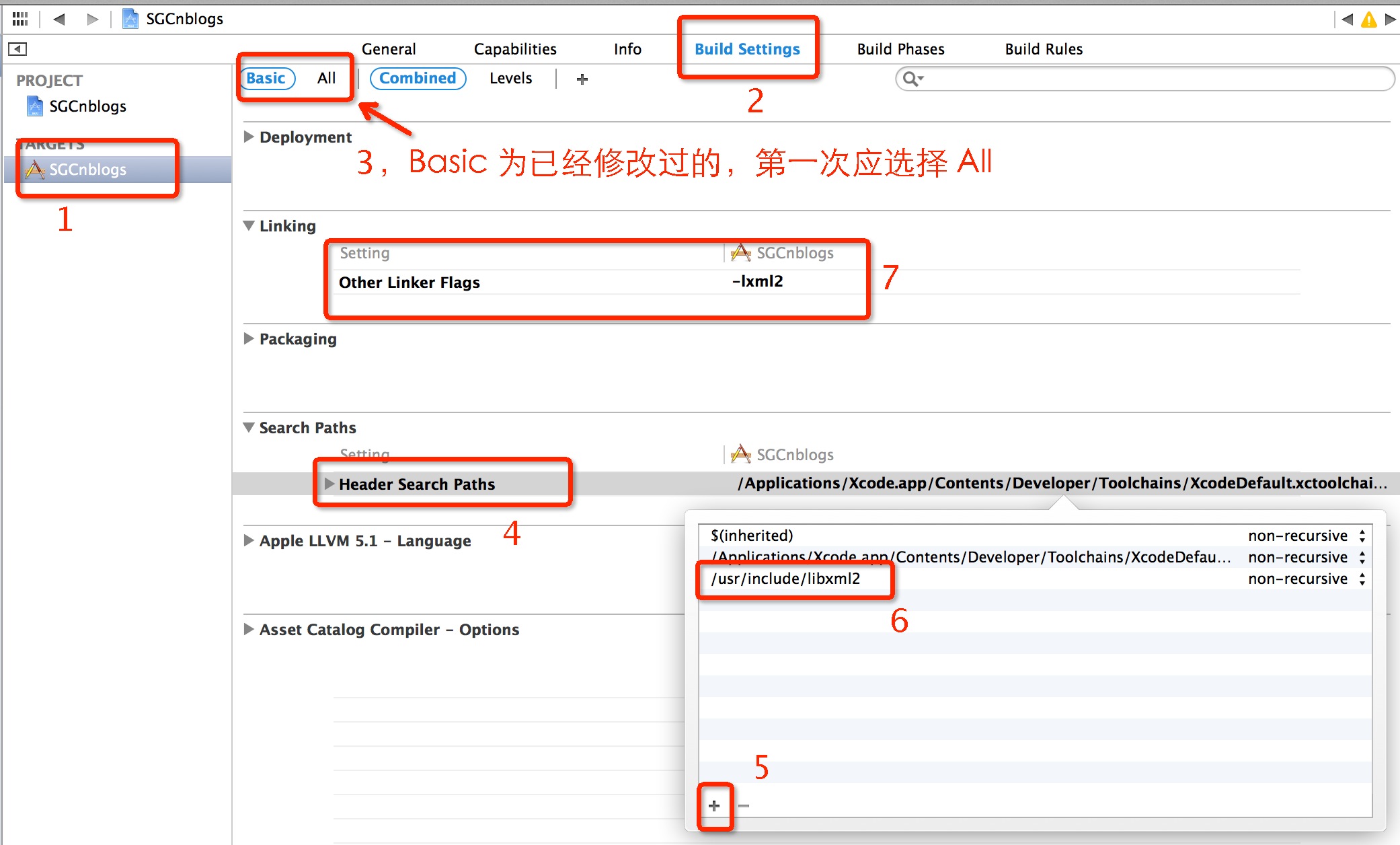
新建一个 SGHomeTableViewController,继承自 UITableViewController,用来显示博文列表;
SGAppDelegate 里实例化 SGHomeTableViewController,并使用 UINavigationController 做界面切换模式:
SGHomeTableViewController *homeVC = [[SGHomeTableViewController alloc] init]; homeVC.title = @"博客园"; UINavigationController *navigationController = [[UINavigationController alloc] initWithRootViewController:homeVC]; self.window.rootViewController = navigationController;
根据 RSS 数据的结构,分别新建3个 Model:SGCnblogsFeedModel、SGCnblogsEntryModel、SGCnblogsAuthorModel,加上各自的属性:
@interface SGCnblogsFeedModel : NSObject @property (nonatomic, strong) NSString *title; @property (nonatomic, strong) NSString *subtitle; @property (nonatomic, strong) NSString *id; @property (nonatomic, strong) NSString *updated; @property (nonatomic, strong) NSString *generator; @property (nonatomic, strong) NSMutableArray *enties; @end
@interface SGCnblogsEntryModel : NSObject @property (nonatomic, strong) NSString *id; @property (nonatomic, strong) NSString *title; @property (nonatomic, strong) NSString *summary; @property (nonatomic, strong) NSString *published; @property (nonatomic, strong) NSString *updated; @property (nonatomic, strong) SGCnblogsAuthorModel *author; @property (nonatomic, strong) NSString *content; @end
@interface SGCnblogsAuthorModel : NSObject @property (nonatomic, strong) NSString *name; @property (nonatomic, strong) NSString *uri; @end
——数据获取
新建一个 Helper -- SGCnblogsRSSHelper,用于请求 RSS 数据。对外提供一个类方法:
+ (void)requestCnblogsRSSWithHandleSuccess:(void (^)(SGCnblogsFeedModel *feedModel))success handleFailure:(void (^)(NSError *error))failure;
success 用于处理请求成功后的操作,传入 Response 数据(已封装成 SGCnblogsFeedModel);
failure 用于处理请求失败后的操作,传入错误信息;
#define URL_CNBLOGSRSS @"http://feed.cnblogs.com/blog/sitehome/rss" + (void)requestCnblogsRSSWithHandleSuccess:(void (^)(SGCnblogsFeedModel *feedModel))success handleFailure:(void (^)(NSError *error))failure { // 使用 AFNetworking AFHTTPRequestOperationManager *manager = [AFHTTPRequestOperationManager manager]; // 用 GET 方式请求 RSS [manager GET:URL_CNBLOGSRSS parameters:nil success:^(AFHTTPRequestOperation *task, id responseObject) { NSLog(@"responseObject: %@", responseObject); } failure:^(AFHTTPRequestOperation *task, NSError *error) { NSLog(@"error: %@", error); } ]; }
使用 AFHTTPRequestOperationManager 的 GET 方法,先做个简单测试,Debug 后看到打印出的部分 log 如下:

"无法接收这个类型的内容"。
AFHTTPRequestOperationManager 可设置 request 和 response 的类型,跟踪进 [AFHTTPRequestOperationManager manager] 方法可看到这里实例化出来的 response 类型是 [AFJSONResponseSerializer serializer],我需要的是 application/atom+xml,只需在实例化后再加上以下两句:
// 设置请求 manager.responseSerializer = [AFHTTPResponseSerializer serializer]; manager.responseSerializer.acceptableContentTypes = [NSSet setWithObject:@"application/atom+xml"];
再次 Debug 测试:
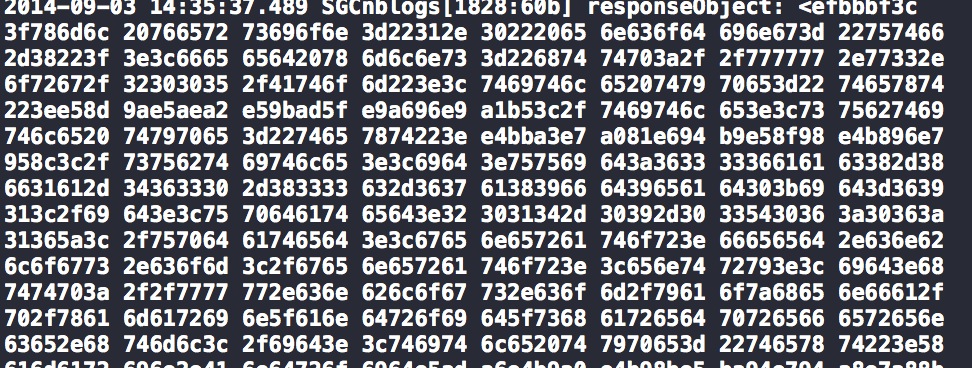
数据拿到了,接着就是解析、封装。
我在这步卡了很久,原因是 Debug 进入后,看到的数据并不是 XML 字符串格式的,而是这样的:

error?!!后来找了很久,才知道原来要这么转才能得到 XML 字符串:
// 处理 Response 数据 NSString *rssString = nil; if ([responseObject isKindOfClass:[NSData class]]) { rssString = [[NSString alloc] initWithData:responseObject encoding:NSUTF8StringEncoding]; } else { rssString = (NSString *)responseObject; }
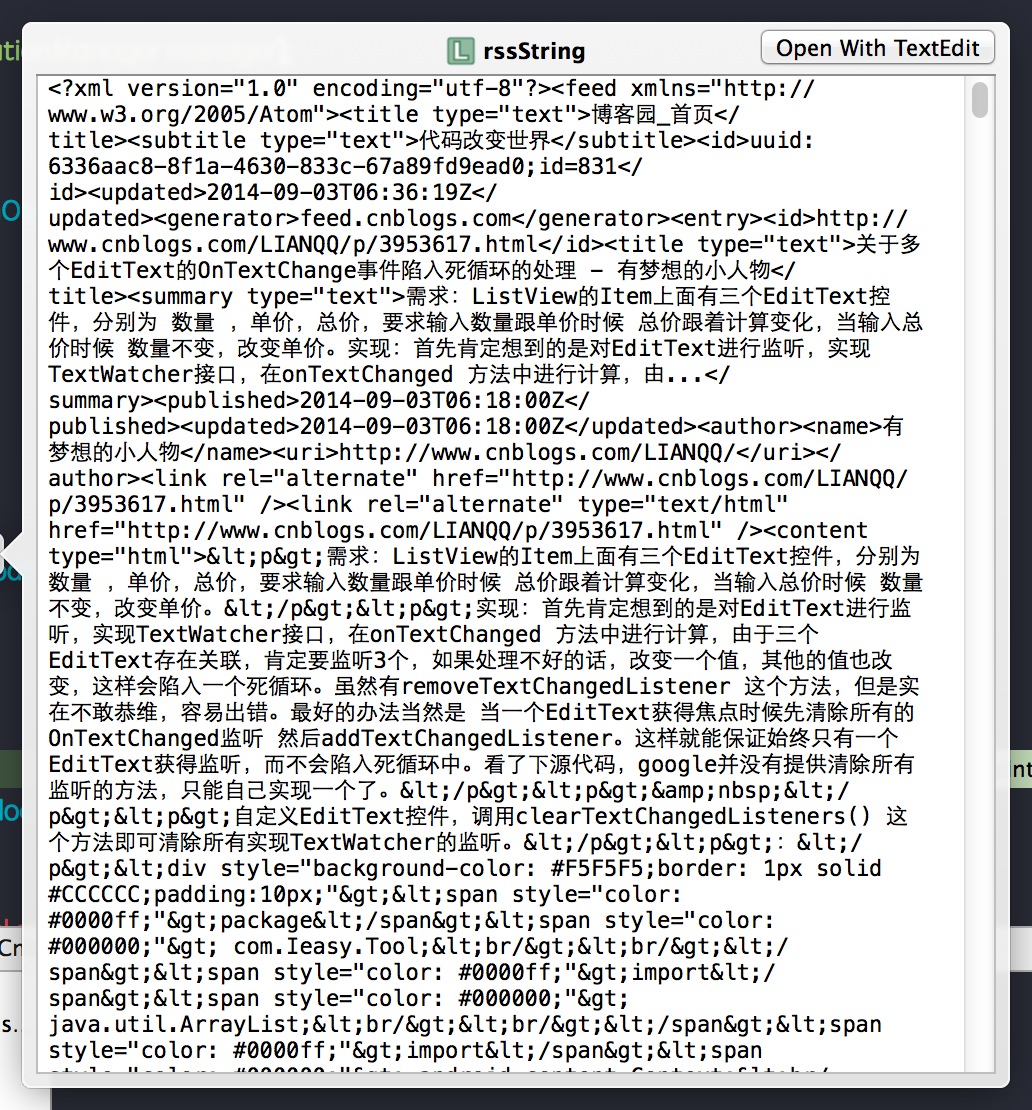
——数据解析、封装
XML 字符串数据,最终解析、封装成 SGCnblogsFeedModel。我在 SGCnblogsFeedModel 中对外提供一个构造函数(initWithRSSString:),传进 XML 字符串后,自动解析、封装成 SGCnblogsFeedModel 实例:
- (id)initWithRSSString:(NSString *)rssString { if (self = [super init]) { // 使用 GDataXML 解析字符串 GDataXMLDocument *xmlDoc = [[GDataXMLDocument alloc] initWithXMLString:rssString options:0 error:nil]; GDataXMLElement *rootEle = [xmlDoc rootElement]; self.title = [[[rootEle elementsForName:@"title"] objectAtIndex:0] stringValue]; self.subtitle = [[[rootEle elementsForName:@"subtitle"] objectAtIndex:0] stringValue]; self.id = [[[rootEle elementsForName:@"id"] objectAtIndex:0] stringValue]; self.updated = [[[rootEle elementsForName:@"updated"] objectAtIndex:0] stringValue]; self.generator = [[[rootEle elementsForName:@"generator"] objectAtIndex:0] stringValue]; self.enties = [[NSMutableArray alloc] init]; for (GDataXMLElement *entryEle in [rootEle elementsForName:@"entry"]) { SGCnblogsEntryModel *entryModel = [[SGCnblogsEntryModel alloc] init]; entryModel.id = [[[entryEle elementsForName:@"id"] objectAtIndex:0] stringValue]; entryModel.title = [[[entryEle elementsForName:@"title"] objectAtIndex:0] stringValue]; entryModel.summary = [[[entryEle elementsForName:@"summary"] objectAtIndex:0] stringValue]; entryModel.published = [[[entryEle elementsForName:@"published"] objectAtIndex:0] stringValue]; entryModel.updated = [[[entryEle elementsForName:@"updated"] objectAtIndex:0] stringValue]; entryModel.content = [[[entryEle elementsForName:@"content"] objectAtIndex:0] stringValue]; GDataXMLElement *authorEle = [[entryEle elementsForName:@"author"] objectAtIndex:0]; entryModel.author = [[SGCnblogsAuthorModel alloc] init]; entryModel.author.name = [[[authorEle elementsForName:@"name"] objectAtIndex:0] stringValue]; entryModel.author.uri = [[[authorEle elementsForName:@"uri"] objectAtIndex:0] stringValue]; [self.enties addObject:entryModel]; } } return self; }
最简单粗暴的解析,这里不多做说明了。
SGCnblogsRSSHelper 里的 GET 方法修改成这样:
// 用 GET 方式请求 RSS [manager GET:URL_CNBLOGSRSS parameters:nil success:^(AFHTTPRequestOperation *task, id responseObject) { // 处理 Response 数据 NSString *rssString = nil; if ([responseObject isKindOfClass:[NSData class]]) { rssString = [[NSString alloc] initWithData:responseObject encoding:NSUTF8StringEncoding]; } else { rssString = (NSString *)responseObject; } if (rssString && [rssString length] > 0) { SGCnblogsFeedModel *feedModel = [[SGCnblogsFeedModel alloc] initWithRSSString:rssString]; if (feedModel) { success(feedModel); return; } } failure([NSError errorWithDomain:@"can not parse the rss xml string." code:0 userInfo:nil]); } failure:^(AFHTTPRequestOperation *task, NSError *error) { failure(error); } ];
——数据显示
在 SGHomeTableViewController 中增加一个 SGCnblogsFeedModel 属性,同时实现 UITableViewDataSource 中以下4个 Delegate:
- (NSInteger)numberOfSectionsInTableView:(UITableView *)tableView;
- (NSInteger)tableView:(UITableView *)tableView numberOfRowsInSection:(NSInteger)section;
- (CGFloat)tableView:(UITableView *)tableView heightForRowAtIndexPath:(NSIndexPath *)indexPath;
- (UITableViewCell *)tableView:(UITableView *)tableView cellForRowAtIndexPath:(NSIndexPath *)indexPath;
并在 viewDidLoad 中,绑定数据(同样也可以放在 init 方法中,这样就不需要 reload data 了):
@interface SGHomeTableViewController() @property (nonatomic, strong) SGCnblogsFeedModel *feedModel; @end - (void)viewDidLoad { [super viewDidLoad]; [SGCnblogsRSSHelper requestCnblogsRSSWithHandleSuccess:^(SGCnblogsFeedModel *feedModel) { self.feedModel = feedModel; // 重新渲染界面 [self.tableView reloadData]; } handleFailure:^(NSError *error) { NSLog(@"%@", error); }]; } #pragma mark - UITableViewDataSource /** 设置 Section 数 */ - (NSInteger)numberOfSectionsInTableView:(UITableView *)tableView { return 1; } /** 设置每个 Section 对应的数据行数 */ - (NSInteger)tableView:(UITableView *)tableView numberOfRowsInSection:(NSInteger)section { return self.feedModel && self.feedModel.enties ? self.feedModel.enties.count : 0; } /** 设置每行高度 */ - (CGFloat)tableView:(UITableView *)tableView heightForRowAtIndexPath:(NSIndexPath *)indexPath { return 105; } /** 绑定每行数据 */ - (UITableViewCell *)tableView:(UITableView *)tableView cellForRowAtIndexPath:(NSIndexPath *)indexPath { // 重用 TableViewCell SGCnblogsEntryTableViewCell *cell = [tableView dequeueReusableCellWithIdentifier:@"SGCnblogEntryTableViewCell"]; if (!cell) { cell = [[SGCnblogsEntryTableViewCell alloc] init]; } // 加载界面 [cell loadView:self.feedModel && self.feedModel.enties ? [self.feedModel.enties objectAtIndex:indexPath.row] : nil]; return cell; }
这里用到 SGCnblogsEntryTableViewCell,这个是我自定义的一个继承自 UITableViewCell 的 TableViewCell,用于显示博文列表页每一行的数据,这个类对外提供一个实例方法:
- (void)loadView:(SGCnblogsEntryModel *)entryModel;
简单的将数据显示出来,这里不贴出代码了,看看 Run 的结果:
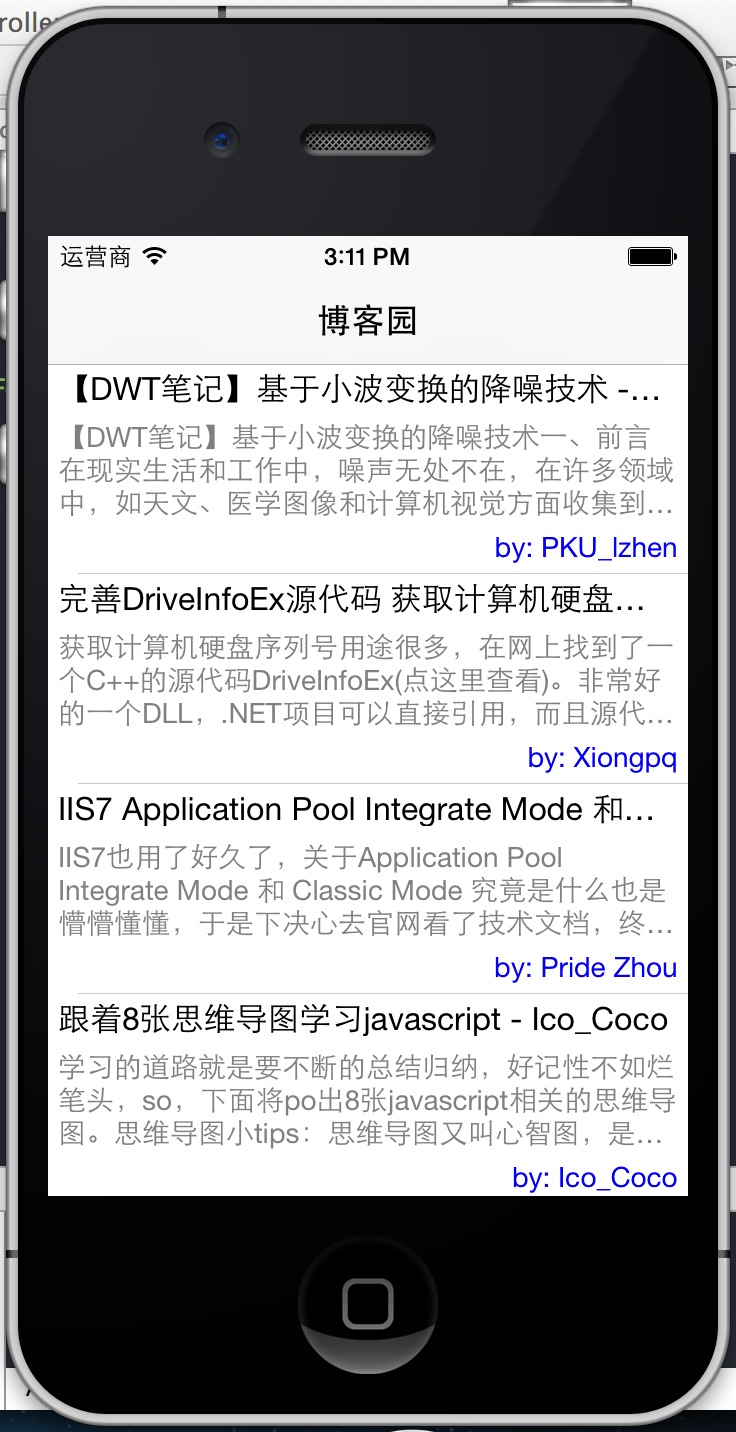
——界面跳转
接着实现列表每一行的点击事件,当点击某一行时,界面切换到博文详细页。只需在 SGHomeTableViewController 中实现 UITableViewDelegate 中的
tableView:didSelectRowAtIndexPath: 方法即可:
#pragma mark - UITableViewDelegate /** 处理点击事件 */ - (void)tableView:(UITableView *)tableView didSelectRowAtIndexPath:(NSIndexPath *)indexPath { SGCnblogsEntryModel *entryModel = self.feedModel && self.feedModel.enties ? [self.feedModel.enties objectAtIndex:indexPath.row] : nil; SGEntryViewController *entryVC = [[SGEntryViewController alloc] initWithEntryModel:entryModel]; [self.navigationController pushViewController:entryVC animated:YES]; }
获取到对应的 Model 后,使用 Navigation Push 一个新 Controller。
SGEntryViewController 是我自定义的一个 ViewController,继承自 UIViewController,增加一个 SGCnblogsEntryModel 属性,并且对外提供一个构造函数(initWithEntryModel:)。
这个界面用于显示博文的详细内容,代码不贴出来了,看看简单效果:
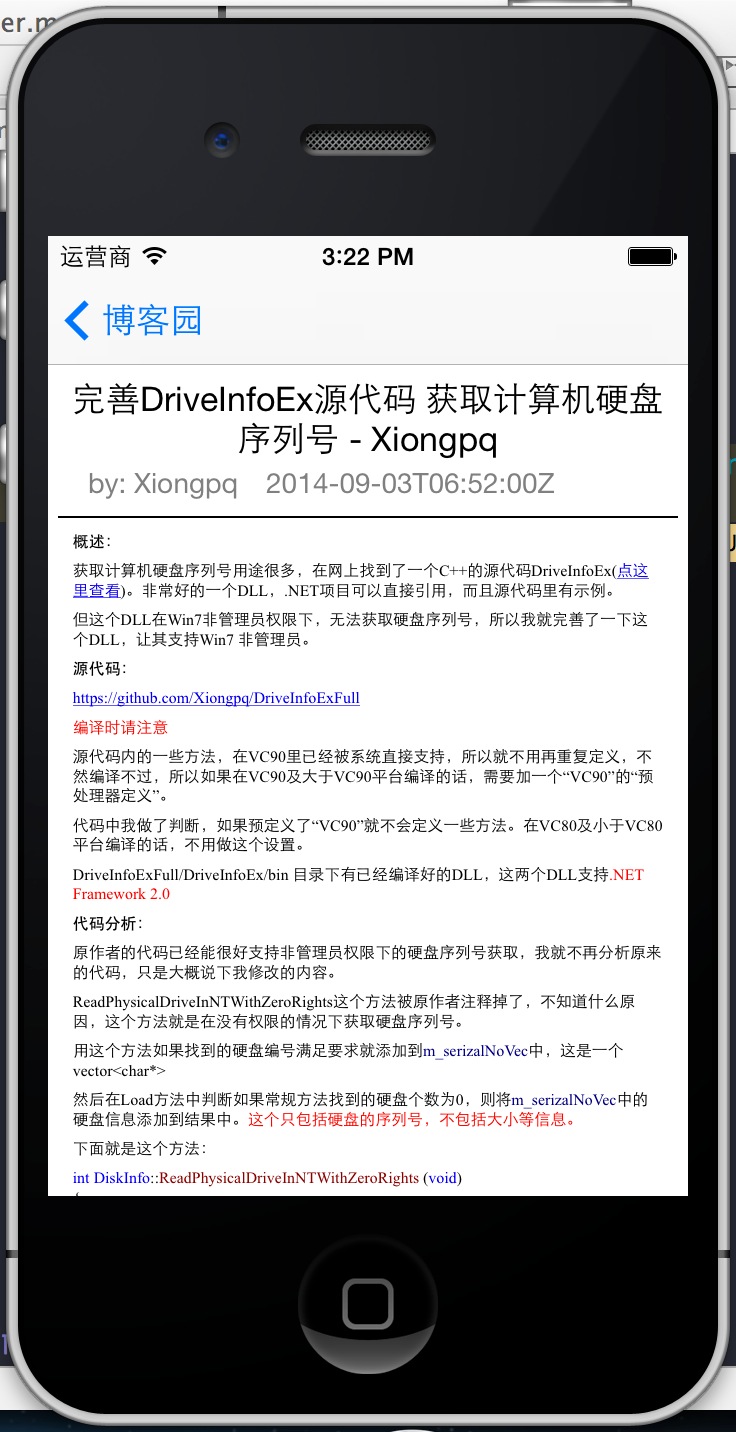
我还想增加一个功能,能够跳转到原文页面。
于是我在这个界面的 NavigationItem 处添加一个右侧按钮,点击跳转到原文页面。在 initWithEntryModel: 中添加以下代码:
// 查看原文按钮 UIBarButtonItem *rightBarBtn = [[UIBarButtonItem alloc] initWithTitle:@"原文" style:UIBarButtonItemStyleBordered target:self action:@selector(selectedRightAction:)]; self.navigationItem.rightBarButtonItem = rightBarBtn;
并且实现对应的点击响应方法(selectedRightAction:):
- (void)selectedRightAction:(UIBarButtonItem *)rightBarBtn { SGWebViewController *webVC = [[SGWebViewController alloc] initWithUrl:self.entryModel.id]; [self.navigationController pushViewController:webVC animated:YES]; }
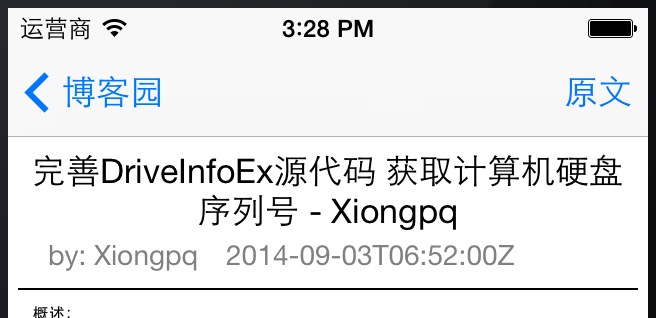
SGWebViewController,继承自 UIViewController,用来加载网络页面,这里没做返回、前进、重加载等功能,只是简单显示。
直接贴代码和效果图:
@interface SGWebViewController() @property (nonatomic, strong) NSString *url; @end @implementation SGWebViewController - (id)initWithUrl:(NSString *)url { if (self = [super init]) { self.url = url; } return self; } - (void)viewDidLoad { [super viewDidLoad]; NSURL *url = [NSURL URLWithString:self.url]; NSURLRequest *request = [NSURLRequest requestWithURL:url]; UIWebView *webView = [[UIWebView alloc] init]; webView.frame = CGRectMake(0, 0, self.view.frame.size.width, self.view.frame.size.height); // 适应屏幕大小 webView.scalesPageToFit = YES; [webView loadRequest:request]; [self.view addSubview:webView]; }
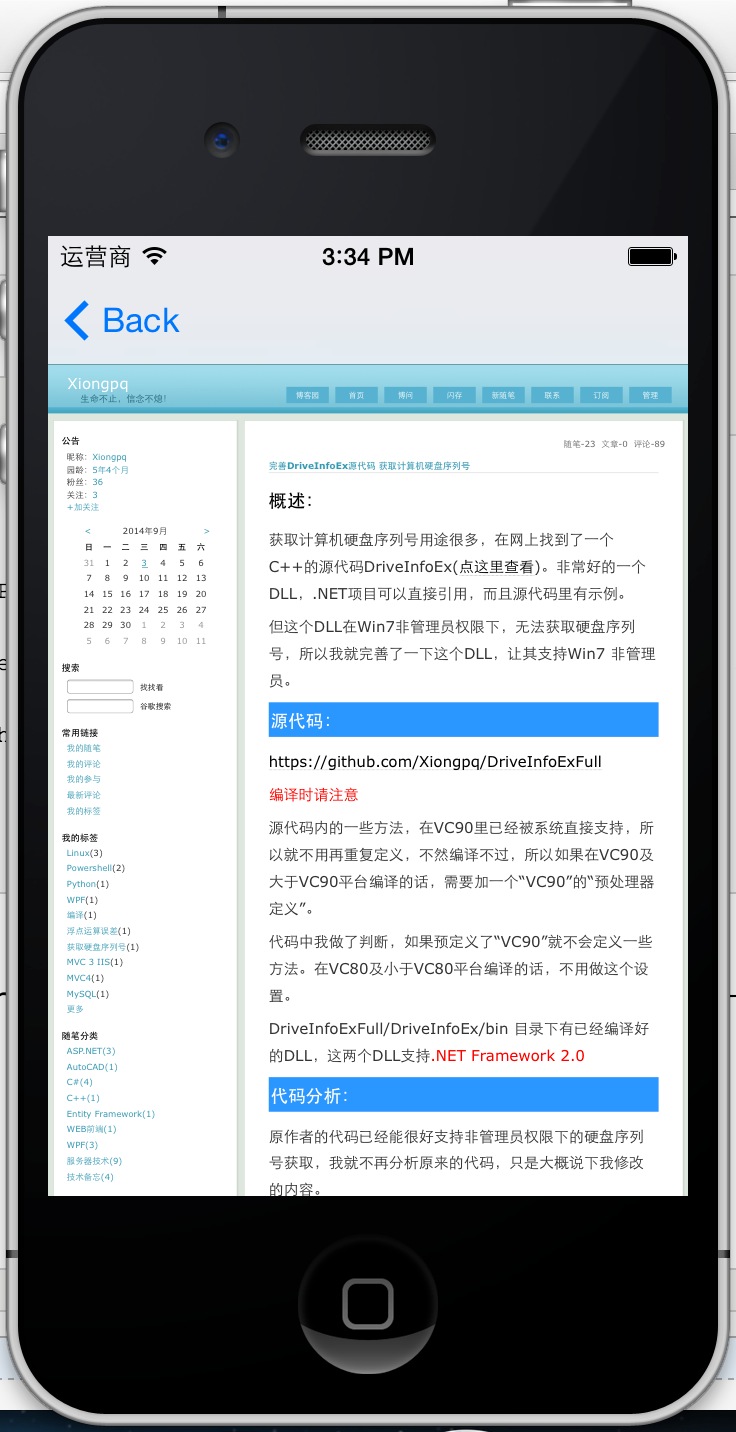
结语:
最后的文档结构是:
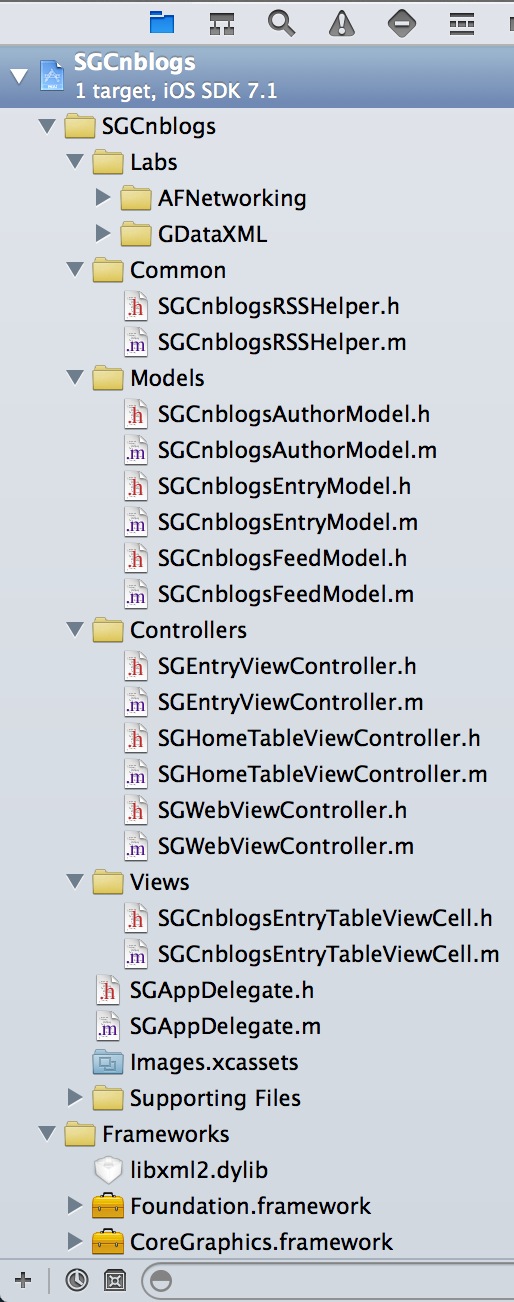
项目已放到 Github 上:https://github.com/SugarLSG/SGCnblogs